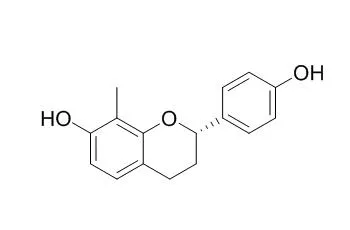METHODS AND RESULTS:
Two new homoisoflavonoids, dracaeconolide A (1) and dracaeconolide B (2), together with ten known compounds, namely (3R)-7,4'-dihydroxy-8-methoxyhomoisoflavane (3), (3R)-7-hydroxy-3-(4-hydroxybenzyl)chromane (4), (3R)-7,4'-dihydroxy-5-methoxy-homoisoflavane (5), (3R)-6,4'-dihydroxy-8-methoxyhomoisoflavan (6), 7,4'-Dihydroxy-8-methylflavan (7), (2R)-7,4'-dihydroxy-5-methoxy-8-methylflavan (8), 5,4'-dihydroxy-7-methoxy-6-methylflavane (9), 7,4'-dihydroxy-3'-methoxyflavan (10), 7,4'-dihydroxyflavan (11), 4,4'-dihydroxy-2,6-dimethoxydihydrochlcone (12), were isolated from the red resin of Dracaena cochinchinensis (dragon's blood, DB). All the compounds were then evaluated for their effects on mouse bone marrow-derived mesenchymal stem cells (MSCs) proliferation using CCK8 assay and their abilities in promoting MSCs differentiating into osteoblast through the assay of alkaline phosphatase (ALP) activity in vitro.
CONCLUSIONS:
Compounds 2, 3, 4, 7, 9, and 11, at a concentration of 10μM with no cytotoxicity, significantly promoted MSC osteogenic differentiation by increasing the levels of ALP activity to percents of 159.6±5.9, 167.6±10.9, 162.0±1.4, 151.3±4.0, 171.0±8.2, and 169.9±7.3 in relative to the control, respectively. The results of ALP staining were in accordance to that of ALP activity. |






 Cell. 2018 Jan 11;172(1-2):249-261.e12. doi: 10.1016/j.cell.2017.12.019.IF=36.216(2019)
Cell. 2018 Jan 11;172(1-2):249-261.e12. doi: 10.1016/j.cell.2017.12.019.IF=36.216(2019) Cell Metab. 2020 Mar 3;31(3):534-548.e5. doi: 10.1016/j.cmet.2020.01.002.IF=22.415(2019)
Cell Metab. 2020 Mar 3;31(3):534-548.e5. doi: 10.1016/j.cmet.2020.01.002.IF=22.415(2019) Mol Cell. 2017 Nov 16;68(4):673-685.e6. doi: 10.1016/j.molcel.2017.10.022.IF=14.548(2019)
Mol Cell. 2017 Nov 16;68(4):673-685.e6. doi: 10.1016/j.molcel.2017.10.022.IF=14.548(2019)